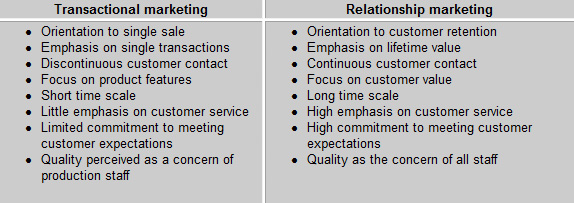
Elements of Transactional & Relationship Marketing Differences:
Transactional marketing
- Orientation to single sale
- Emphasis on single transactions
- Discontinuous customer contact
- Focus on product features
- Short time scale
- Little empahsis on customer service
- Limited commitment to meeting customer expectations
- Quality perceived as a concern of production staff
Relationship Marketing:
- Orientation to customer retention
- Emphasis on lifetime value
- Continuous customer contact
- Focus on customer value
- Long time scale
- High emphasis on customer service
- High commitment to meeting customer expectations
- Quality as the concern of all staff
Principle:
List the difference in Transactional and relationship Marketing
Issues:
Three unique aspects to Relationship Marketing:
- one-to-one relationship between the marketer and the customer, on an individual level, not aggregate like a segment
- interactive process rather than an exchange, traditional marketing is based on exchange and transactions, while RM is based on interaction and activities
- it is value-added activity, through mutual interdependence and collaboration between suppliers and customers
Main drivers for RM:
- Sustained value to key-stakeholders
RM perspectives:
- Connected networks where interdependence and co-operation develop RM strategy
Applications:
To develop and use resources and competencies to create value
Source of Transactional & Relationship Marketing Differences:
Based on Payne (1995)






